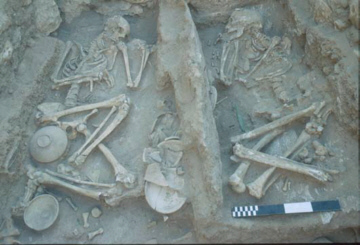
News Release
|
Office of News and Information Johns Hopkins University 3003 N. Charles Street, Suite 100 Baltimore, Maryland 21218-3843 Phone: (410) 516-7160 | Fax (410) 516-5251 |
October 2, 2000 FOR IMMEDIATE RELEASE CONTACT: Leslie Rice lnr@jhu.edu |
Untouched Ancient Tomb
Mysterious Skeletons Ornamented in
Gold, Silver Suggest Royalty or Ritual
(Note to reporters: High resolution digital images of findings are available by request for media only)
An ancient, untouched tomb of what may be royalty from one of the world's first city-dwelling civilizations has been discovered in Syria, containing human and animal remains, gold and silver treasures and unbroken artifacts that had not been disturbed for about 4,300 years.
The tomb was discovered during the summer by a team of archeologists from The Johns Hopkins University, working in Umm el-Marra, what is believed to be the site of ancient Tuba, one of Syria's first cities.
 "This is one of the earliest urban civilizations
in the world," said Glenn Schwartz (pictured at left),
leader of the team
and professor of Near Eastern
Studies in the Krieger School of
Arts and Sciences at Johns Hopkins. "By studying
Syria, we can learn more about the different ways urban
societies developed, why they developed when and how
they did, and how they differed from each other. It's
an important addition to our understanding of why
cities, writing, states and social classes first
developed."
"This is one of the earliest urban civilizations
in the world," said Glenn Schwartz (pictured at left),
leader of the team
and professor of Near Eastern
Studies in the Krieger School of
Arts and Sciences at Johns Hopkins. "By studying
Syria, we can learn more about the different ways urban
societies developed, why they developed when and how
they did, and how they differed from each other. It's
an important addition to our understanding of why
cities, writing, states and social classes first
developed."
The tomb was remarkably intact and contained five adults and three babies, some of whom were ornamented head-to-toe in gold and silver. It may be the oldest intact royal tomb yet to be found in Syria, Schwartz said. It included three layers of skeletons. The top layer includes traces of two coffins, each containing a young woman in her 20s and a baby. The women were the most richly ornamented of all the occupants of the tomb, with jewelry of silver, gold and lapis lazuli. Also of interest on this level was an accompanying lump of iron, possibly from a meteorite. One of the babies appeared to be wearing a bronze torque, or collar.
In the layer below were coffins of two adult males and the remains of a baby at some distance from both men, close to the entrance of the tomb. This differs from the placement babies in the upper layer, where they were placed next to the women's bodies. Crowning the older man was a silver diadem decorated with a disk bearing a rosette motif, while the man opposite had a bronze dagger. The third and lowest layer held an adult male with a silver cup and silver pins.
 |
| Skeletons of two men, second layer. |
All the individuals were accompanied by scores of ceramic vessels, some of which contained animal bones that may have been part of funerary animal offerings. Outside the tomb to the south, against the tomb wall, was a jar containing the remains of a baby, a spouted jar, and two decapitated skulls, horselike but apparently belonging neither to horses or donkeys. The ceramics in the tomb date to around 2300 B.C., the latter part of Egypt's pyramid age.
Now back at Hopkins, Schwartz and his team are working to assess what it all means.
"An important aspect of this discovery is the intact character of the tomb," says Schwartz. "In contrast to elite tombs from the same period found along the Syrian Euphrates in recent years, the Umm el-Marra tomb was not plundered, allowing for unimpeded study of the mortuary ritual involved. What is unclear, at present, is why the tomb was not robbed, particularly if it was an aboveground structure and conspicuous on a high part of the city. Also unclear is the character of the tomb's individuals: why are the most richly adorned persons two young women, each accompanied by a baby? This peculiar aspect may hint at ritual characteristics, rather than a tomb simply reserved for royalty or elite individuals."
The tomb is clearly part of a larger complex: walls extend from the tomb in almost every direction and indicate further structures yet to be investigated. Whether it is part of a palace structure or a larger elaborate ancient cemetery remains to be found during future expeditions.
The city of Tuba was mentioned frequently in second and third millennium B.C. texts. Since 1994, Schwartz and a University of Amsterdam team directed by Hans Curvers have been excavating the city, located on a major east-west route that connected the Mediterranean coast with upper Mesopotamia. Umm el-Marra, the city's modern name, is located about 200 miles northeast of Damascus.
All of the bodies and artifacts found in the tomb remain in safe-keeping in Syria. In the meantime, the tomb has been recovered with earth and hidden until the Hopkins team can return to it in a year or two.
 GO TO
FACTS ABOUT THE TOMB OF
UMM-EL-MARRA
GO TO
FACTS ABOUT THE TOMB OF
UMM-EL-MARRA
 GO TO
IMAGES FROM THE TOMB OF
UMM-EL-MARRA
GO TO
IMAGES FROM THE TOMB OF
UMM-EL-MARRA
|
Some past findings from Johns Hopkins-University of
Amsterdam Umm el-Marra excavations: |
|
Johns Hopkins University news releases can be found on
the
World Wide Web at
http://www.jhu.edu/news_info/news/ Information on automatic e-mail delivery of science and medical news releases is available at the same address.
|
 Go to
Headlines@HopkinsHome Page
Go to
Headlines@HopkinsHome Page